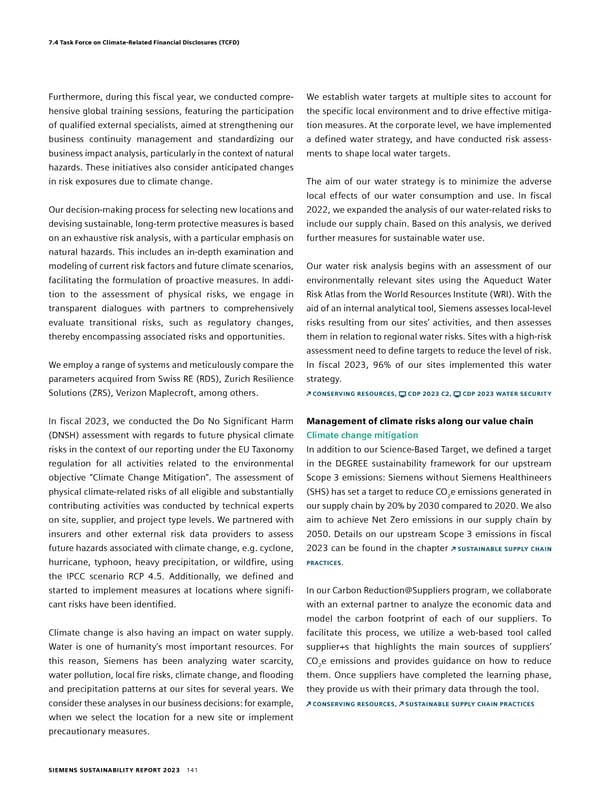7.4 Task Force on ClimateRelated Financial Disclosures (TCFD) Furthermore, during this fiscal year, we conducted compre- We establish water targets at multiple sites to account for hensive global training sessions, featuring the participation the specific local environment and to drive effective mitiga- of qualified external specialists, aimed at strengthening our tion measures. At the corporate level, we have implemented business continuity management and standardizing our a defined water strategy, and have conducted risk assess- business impact analysis, particularly in the context of natural ments to shape local water targets. hazards. These initiatives also consider anticipated changes in risk exposures due to climate change. The aim of our water strategy is to minimize the adverse local effects of our water consumption and use. In fiscal Our decision-making process for selecting new locations and 2022, we expanded the analysis of our water-related risks to devising sustainable, long-term protective measures is based include our supply chain. Based on this analysis, we derived on an exhaustive risk analysis, with a particular emphasis on further measures for sustainable water use. natural hazards. This includes an in-depth examination and modeling of current risk factors and future climate scenarios, Our water risk analysis begins with an assessment of our facilitating the formulation of proactive measures. In addi- environmentally relevant sites using the Aqueduct Water tion to the assessment of physical risks, we engage in Risk Atlas from the World Resources Institute (WRI). With the transparent dialogues with partners to comprehensively aid of an internal analytical tool, Siemens assesses local-level evaluate transitional risks, such as regulatory changes, risks resulting from our sites’ activities, and then assesses thereby encompassing associated risks and opportunities. them in relation to regional water risks. Sites with a high-risk assessment need to define targets to reduce the level of risk. We employ a range of systems and meticulously compare the In fiscal 2023, 96% of our sites implemented this water parameters acquired from Swiss RE (RDS), Zurich Resilience strategy. Solutions (ZRS), Verizon Maplecroft, among others. CONSERVING RESOURCES, CDP 2023 C2, CDP 2023 WATER SECURITY In fiscal 2023, we conducted the Do No Significant Harm Management of climate risks along our value chain (DNSH) assessment with regards to future physical climate Climate change mitigation risks in the context of our reporting under the EU Taxonomy In addition to our Science-Based Target, we defined a target regulation for all activities related to the environmental in the DEGREE sustainability framework for our upstream objective “Climate Change Mitigation”. The assessment of Scope 3 emissions: Siemens without Siemens Healthineers physical climate-related risks of all eligible and substantially (SHS) has set a target to reduce CO e emissions generated in 2 contributing activities was conducted by technical experts our supply chain by 20% by 2030 compared to 2020. We also on site, supplier, and project type levels. We partnered with aim to achieve Net Zero emissions in our supply chain by insurers and other external risk data providers to assess 2050. Details on our upstream Scope 3 emissions in fiscal future hazards associated with climate change, e.g. cyclone, 2023 can be found in the chapter SUSTAINABLE SUPPLY CHAIN hurricane, typhoon, heavy precipitation, or wildfire, using PRACTICES. the IPCC scenario RCP 4.5. Additionally, we defined and - In our Carbon Reduction@Suppliers program, we collaborate started to implement measures at locations where signifi cant risks have been identified. with an external partner to analyze the economic data and model the carbon footprint of each of our suppliers. To Climate change is also having an impact on water supply. facilitate this process, we utilize a web-based tool called Water is one of humanity’s most important resources. For supplier+s that highlights the main sources of suppliers’ this reason, Siemens has been analyzing water scarcity, CO2e emissions and provides guidance on how to reduce water pollution, local fire risks, climate change, and flooding them. Once suppliers have completed the learning phase, and precipitation patterns at our sites for several years. We they provide us with their primary data through the tool. consider these analyses in our business decisions: for example, CONSERVING RESOURCES, SUSTAINABLE SUPPLY CHAIN PRACTICES when we select the location for a new site or implement precautionary measures. SIEMENS SUSTAINABILITY REPORT 2023 141
 Sustainability Report Page 140 Page 142
Sustainability Report Page 140 Page 142